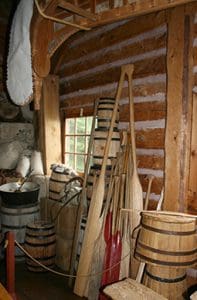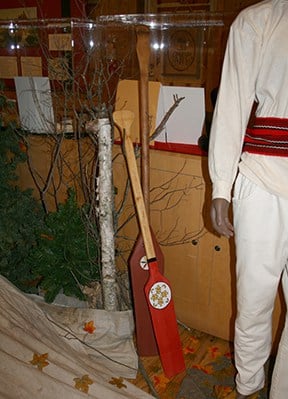Why were the blades of voyageur paddles red? Was it to show them how deep they should paddle? (Darcy)
Hmmm. After only a few hours of paddling, canoeists wouldn’t probably need a marker on their paddles — they would instinctively know how deep to paddle. I’ve continued to puzzle over this, trying to find something about red paddles in old journals. Nothing.
While color would give them style and dash in an otherwise plain world, paint would cost money and voyageurs wouldn’t have much to waste on something frivolous. Where would they get paint? Would it help identify brigades — and why might that be important? Did it have to do with wood preservation?
Finally I contacted Jeremy Ward, curator at the Canadian Canoe Museum in Peterborough, Canada, who had answered my question about the weight of a Montreal canoe.
“Good question. Agreed that voyageurs did not have money to spend on things like paint for personal equipment. The bills of lading issued by the NWC that show the payload contents, crew names and additional equipment (agrets) includes things like setting poles, rop
es (cordelles), tarps (paralas), axe and kettle, repair kit, etc. And no paddles,” Ward wrote.
“This suggests to us that the voyageurs did indeed supply their own paddles. How and when, then, would this rough lot from Montreal area assemble with paddles painted a matching colour? How often were canoes actually paddled using painted paddles (of like colours)?
“Perhaps it might have been more common to see painted paddles in the interior where overwintering voyageurs would have been stationed together and fulfilling chores for the company while waiting for spring canoeing to open up. I recall learning at some point that, more common than red, Spanish Brown would have been a colour that might have been available and used,” Ward surmised.
“Perhaps this was actually uncommon and yet we think it common because the best pictorial representations are from Frances Hopkins’ celebrated paintings that show her accompanying her husband to the Lakehead by voyageur canoe. A six-week trip with a distinguished white woman aboard a canoe was a highly unusual event and perhaps this crew were assigned with fancier fare to impress.”
Ward suggested the chapter on paints used on paddles and canoes in Timothy Kent’s ”Canoes of th e Fur Trade.”
e Fur Trade.”
Kent’s book noted that the painter Francis Anne Hopkins showed painted paddles, and that later, like 1859, blades were painted and ornamented.
on paddles and canoes in Timothy Kent’s ”Canoes of the Fur Trade.” Kent noted that the painter Francis Anne Hopkins showed painted paddles, and that later, like 1859, blades were painted and ornamented.
But from the earliest days (called the French era), Kent’s book indicates paddles may have been ornamented with designs, like straight or wavy black lines, bars and dots, while the shaft had a solid color.
Kent had much more to say about paddles — size, shape of blade and grip, wood used, cost when purchased in 1738, the different paddles used by the steersmen! I’ll explore all that in a future post.




What length were the voyageurs’ paddles? Why were they that size specifically?
Voyageurs copied their middleman’s paddles, about 4 feet long, from Indigenous sources. The length stayed the same but paddles became narrower over time, perhaps because the massive Montreal canoes needed large crews. The steersmen used longer paddles downstream and setting poles (up to 10 feet long) upstream. Because they stood in the canoe’s bow and stern, their paddles had to be longer.
Thank you for an interesting article. I am researching the following; Voyageurs camping equipment, clothing and activities. Any assistance in these areas would be appreciated.
Thank you.
Thank you, Steve, for your question. I get most of my information from books, many of which are out of print, but worth having your library request them or check online for used copies:
Where Two Worlds Meet: The Great Lakes Fur Trade, by Russell Fridley, Minnesota Historical Society, 1982;
A Toast to the Fur Trade: A Picture Essay on Its Material Culture by Robert C. Wheeler. Wheeler Productions, St. Paul, 1985;
The Great Northwest Fur Trade: A Material Culture, 1763-1850 by Ryan R. Gale, Track of the Wolf, Inc, Elk River Minnesota, 2009;
Birchbark Canoes of the Fur Trade, Volume 1 by Timothy J. Kent, Silver Fox Enterprises, Ossineke, Michigan, 1997.
And I enjoy going to all the museums and rendezvous events where I can rub shoulders with people with these same interests. Often the re-enactors have tips about clothing, equipment and other tidbits that are fun and useful to know. If you have a more specific question, I’m glad to address that as well.
In addition, I enjoyed a video by Ray Mears, who interviewed people and took the route himself. Check out my post on Oct. 7, 2017.
But, why are voyagers usually associated with the color red?
Great question. I don’t know for sure. When I examine Francis Anne Hopkins’ paintings, there’s much less red than I expected–a toque, a neckerchief, a shirt, a sash. Only one or so of each. When I wrote about blankets becoming capotes and greatcoats, and then Mackinaw jackets, the color favored by lumberjacks became red/black plaid. Thanks for suggesting a new puzzle to contemplate.